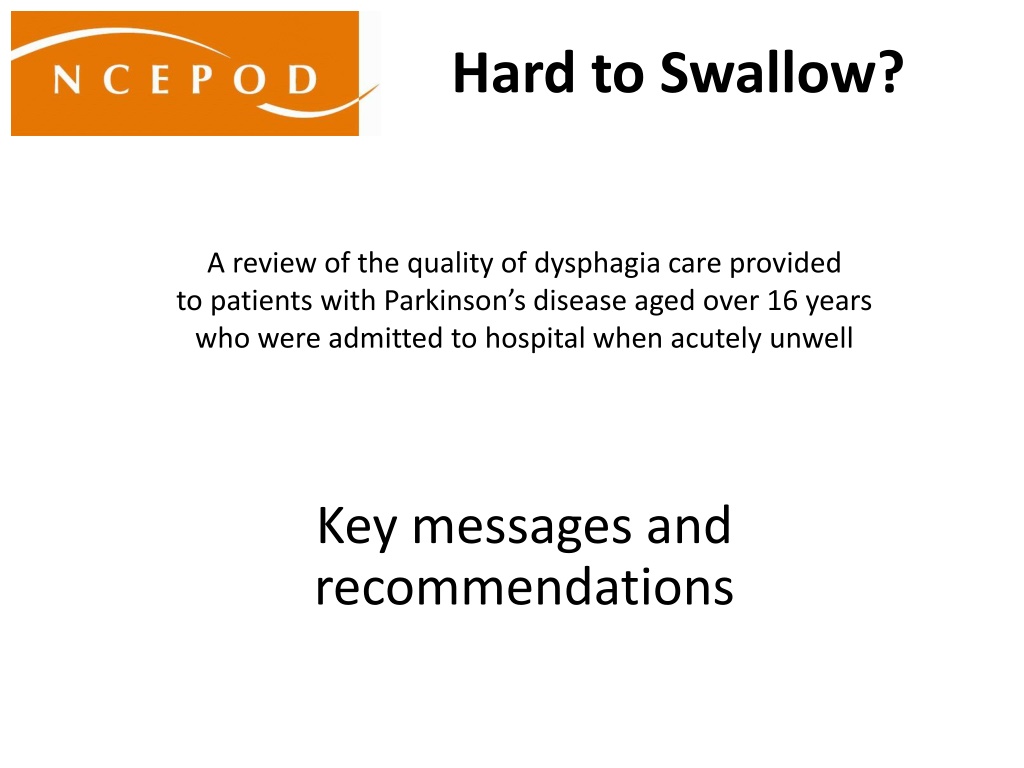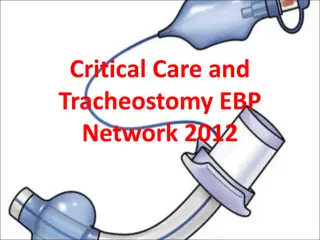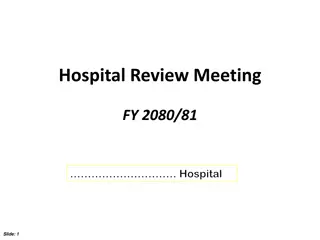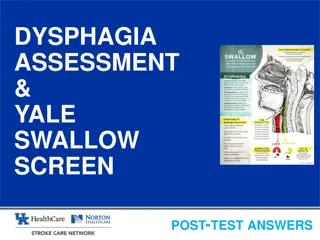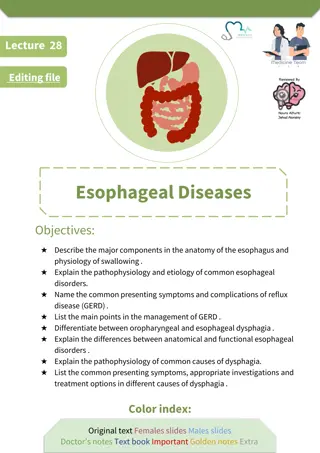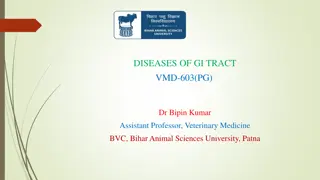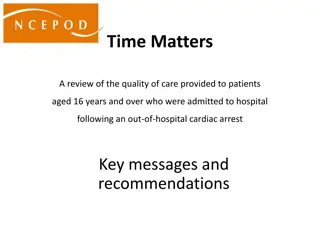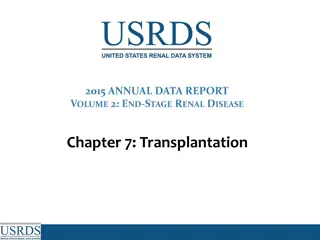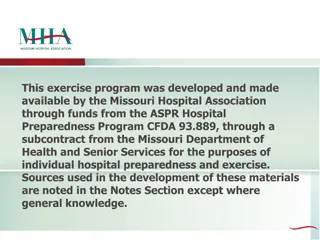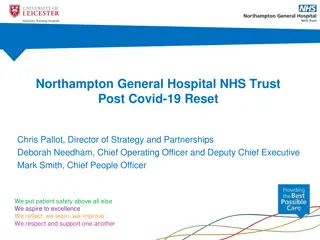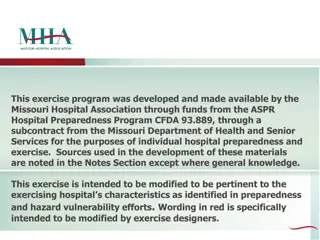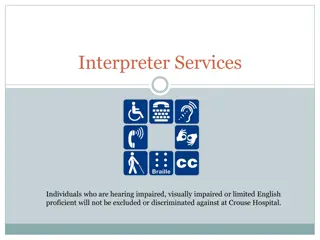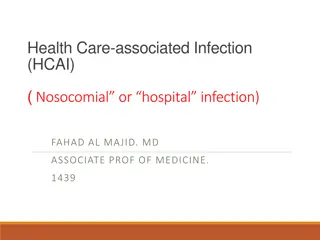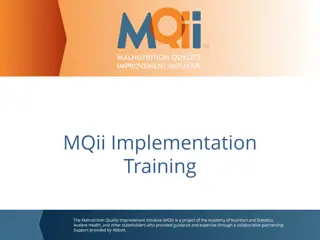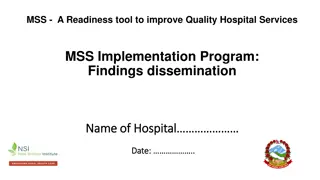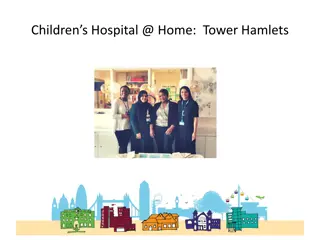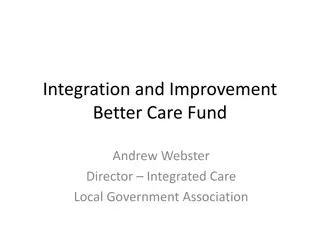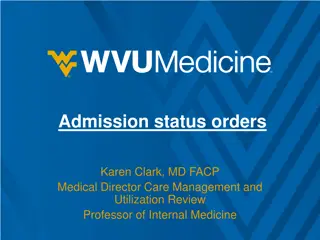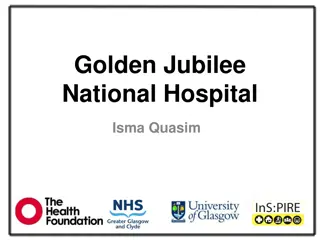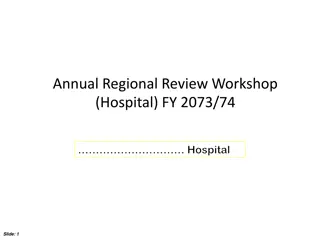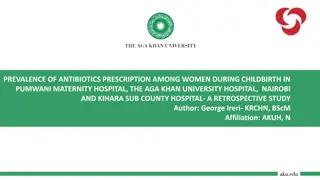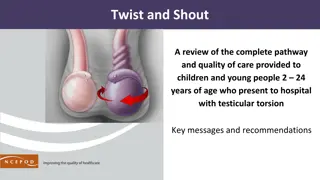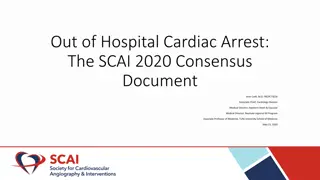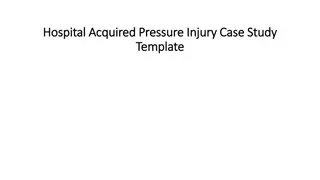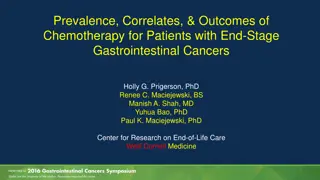Review of Dysphagia Care for Parkinson's Patients in Hospital
A review was conducted on the quality of dysphagia care provided to patients with Parkinson's disease aged over 16 years who were admitted to the hospital when acutely unwell. Key findings include the importance of documenting swallow status in referral letters, screening patients for swallowing difficulties at admission, and assessing overall care quality during hospital stays. Recommendations focus on improving dysphagia assessment and communication for better patient outcomes.
Uploaded on Oct 02, 2024 | 0 Views
Download Presentation

Please find below an Image/Link to download the presentation.
The content on the website is provided AS IS for your information and personal use only. It may not be sold, licensed, or shared on other websites without obtaining consent from the author. Download presentation by click this link. If you encounter any issues during the download, it is possible that the publisher has removed the file from their server.
E N D
Presentation Transcript
Hard to Swallow? A review of the quality of dysphagia care provided to patients with Parkinson s disease aged over 16 years who were admitted to hospital when acutely unwell Key messages and recommendations
The study A review of the quality of dysphagia care provided to patients with Parkinson s disease aged over 16 years who were admitted to hospital when acutely unwell Organisational questionnaire Clinician questionnaire Case note review Patient/carer online survey
Study population Adult patients aged 16 and over with PD who were acutely unwell and admitted to hospital between 7th January and 3rd March 2019. Exclusions Patients admitted as a day case, as not enough data would be available for a review Patients who were admitted to Level 3 (ICU/ITU) critical care, as they may have been intubated Patients who were admitted to independent hospitals, as this group of patients were unlikely to be acutely unwell
Overall assessment of dysphagia care Figure 11.1 Assessment of the overall dysphagia care the patient received during the admission Case reviewer data
Overall assessment of care Figure 11.2 Assessment of the overall quality of care the patient received while in hospital Case reviewer data
Key messages (1) Document the swallow status of all patients with Parkinson s disease at the point of referral to hospital. Since dysphagia can occur at every stage of PD it is important to assess and communicate its presence in a referral letter. Information relating to dysphagia was not available in the referral letter of 20/79 patients who were known to have dysphagia at the point of referral.
Key messages (2) Screen patients with PD for swallowing difficulties at admission Patients admitted to hospital may have swallowing difficulties, not recorded as dysphagia . Other indicators should be considered, such as the patient s ability to swallow food, fluids or medication, whether they have control of saliva or have a history of pneumonia.
Key messages (3) Refer patients with PD who have swallowing difficulties (or who have problems with communication) to speech and language therapy Early input, as needed, from speech and language therapy (SLT) is fundamental to improving swallowing difficulties and communication for many patients with dysphagia. In this study referral to SLT was made following a swallowing screen on arrival for 51/209 (24.4%) patients and case reviewers were of the opinion that a further 36/132 (27.3%) patients should have been referred.
Key messages (4) Notify the specialist PD service (hospital and/or community) when a patient with PD is admitted, if there is any indication that there has been a deterioration or progression of their clinical state For any team caring for a patient with PD it is important to know if there has been any unexpected change in the patient s clinical status or care plan. While a majority of patients in this study were under the care of a PD service prior to their admission, there was no evidence of contact with their PD service, on admission, documented in 180/316 (57%) sets of notes.
Key messages (5) Provide written information at discharge on how to manage swallowing difficulties At the point of discharge from hospital any changes in care or medication, as well as swallowing status (including the ability to take oral medication), nutrition plan or level of future risk of dysphagia should be provided to care providers as well as the patient and/family members.
Recommendation 1 Document the swallow status of all patients with Parkinson s disease at the point of referral to hospital. Target audiences: Primary care and community Parkinson s disease teams
Recommendation 2 Notify the specialist Parkinson s disease service (hospital and/or community) when a patient with Parkinson s disease is admitted, if there is any indication that there has been a deterioration or progression of their clinical state. Target audiences: Healthcare professionals who see patients at admission, clinical and medical directors
Recommendation 3 Screen patients with Parkinson s disease for swallowing difficulties at admission, irrespective of the reason for admission. This should include: Ability to swallow food, fluids and medication Control of saliva A history of pneumonia Target audiences: Healthcare professionals who see patients at admission and clinical directors
Recommendation 4 Refer patients with Parkinson s disease who have swallowing difficulties* (or who have problems with communication) to speech and language therapy. Target audiences: Healthcare professionals who see patients throughout their admission and clinical directors
Recommendation 5 Ensure patients are able to take the medication they have been prescribed at, and throughout, their admission. If there are concerns about whether or not the patient can swallow safely consider other formulations of medication (e.g. liquid rather than a tablet) or ways of administering them. Target audiences: Healthcare professionals who see patients at, and throughout, their admission, pharmacists, and clinical directors
Recommendation 6 Ensure there is a hospital policy for the different ways of administering medication and the review of medications at the point of patient discharge. This includes the use of rotigotine patches. Target audiences: Clinical directors, medical directors, hospital pharmacists, specialist Parkinson s disease teams and quality improvement leads
Recommendation 7 Screen the nutritional status of patients admitted to hospital with Parkinson s disease and act on the findings. Target audiences: Clinical directors, dietitians, nutrition team members and healthcare professionals who see patients at, and throughout, their admission
Recommendation 8 Involve speech and language therapists, pharmacists, dietitians and nutrition multidisciplinary (MDT) discussion of patients with Parkinson s disease and swallowing difficulties. team members in any Target audiences: Clinical directors, speech and language therapists, pharmacists, dietitians and nutrition team members
Recommendation 9 Formalise pathways for the provision of modified texture diet and fluids to include input from: Speech and language therapists Pharmacists Dietitians or other nutrition team members Hospital housekeeping and catering services Community care Target audiences: Medical directors, clinical directors, clinical teams caring for patients with dysphagia. This includes speech and language therapists, pharmacists, dietitians, hospital housekeeping and catering services, community Parkinson s disease teams and quality improvement leads
Recommendation 10 Ensure there is a hospital policy for riskfeeding which includes the assessment or re-assessment (if already undertaken at admission) of mental capacity regarding this decision. The policy should state that discussion should involve: Patients Family members and/or carers Speech and language therapists Dietitians/nutrition team members Pharmacists Target audiences: Clinical directors, medical directors, speech and language therapists, pharmacists, dietitians and nutrition team members and quality improvement leads
Recommendation 11 Provide written information at discharge on how to manage swallowing difficulties, including: Swallow status Ability to take oral medication Changes to medication including any new ways of administering them Nutrition screening tool score and care plan including any texture modifications to food and/or fluids Positioning Level of dysphagia risk in the community To: The patient Family members and/or carers Community healthcare professionals (e.g. GP, community PD team, community pharmacist, care home staff) Target audiences: Clinical directors, healthcare professionals who see patients throughout their admission, quality improvement leads
Discussion Are all patients admitted with PD screened for dysphagia at admission? Are patients with swallowing difficulties referred to SLT? Is the patient s ability to take their medicine monitored at and throughout admission? Which specialties are involved with MDT discussions for patients with PD and swallowing difficulties? Are pathways for the provision of modified texture diet and fluids formalised? Is written information on how to manage swallowing difficulties provided at discharge?
Hard to Swallow? Hard to Swallow? Full report, summary and implementation tools are be found at https://www.ncepod.org.uk/2021dysphagia.html
